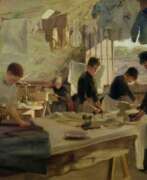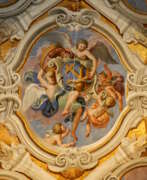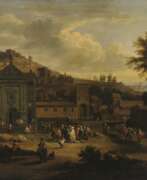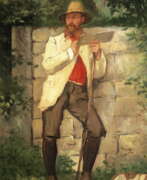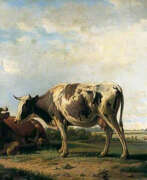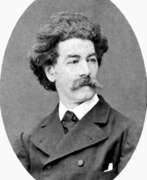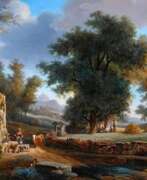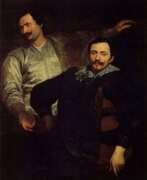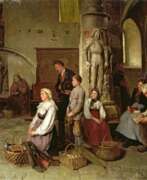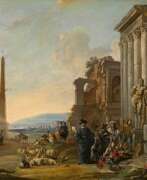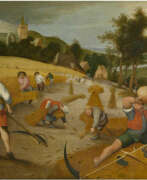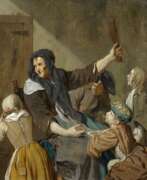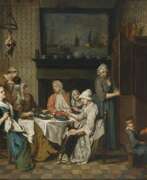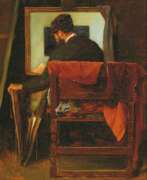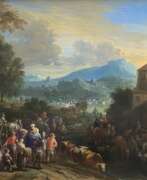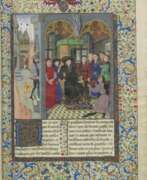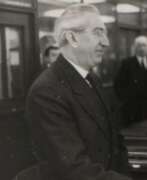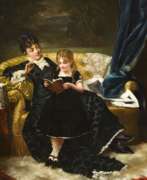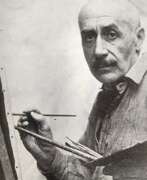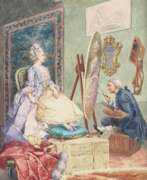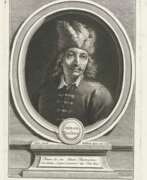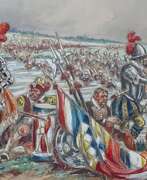Genre painters Belgium
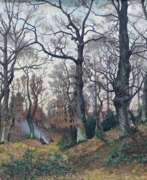

Alphonse Asselbergs was a Belgian painter, primarily of landscapes and forest scenes. Much of his training in art came from Huberti, and he would travel with him in the area around Namur. It was there he befriended Théodore T'Scharner, a student of Ferdinand Marinus, with whom he would go on painting expeditions in the Ardennes. In the summer of 1866, he took an extended trip with Huberti, to the artists' colony at Anseremme, where he was first exposed to the concept of painting en plein aire. In 1867 year he joined the painters at the artists' colony in Tervuren, where he stayed regularly until 1871. The Tervuren Schhol later became known as the Belgian equivalent of the Barbizon School. By 1868, he was receiving good reviews at the salon in Ghent. That same year, he became one of the co-founders of the Société Libre des Beaux-Arts. By 1869, he was exhibiting in Brussels. From 1873 to 1874, he visited Algeria with the watercolorist, Arthur Bouvier. This resulted in a number of Orientalist canvases.
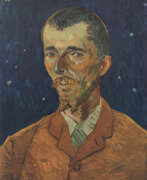

Eugène Boch was a Belgian painter, celebrated for his vibrant contributions to the Post-Impressionist movement. Boch was part of a prominent family known for their fine china business, Villeroy & Boch. He pursued his passion for art in Paris, studying under notable teachers such as Léon Bonnat and Fernand Cormon.
Eugène Boch's artistry is marked by his distinct style and use of color, which earned him spots in prestigious exhibitions like the Salon in Paris during the 1880s. His works, characterized by their emotional depth and innovative techniques, reflect the bold spirit of the Post-Impressionist era. He was not only a painter but also a visionary, whose works resonated with the aesthetic shifts of his time.
One of Eugène Boch's most notable associations was with Vincent van Gogh, who painted Boch in the famous portrait "The Poet," which Van Gogh described as a vision of idealistic and artistic purity. This painting is now housed at the Musée d'Orsay, symbolizing their profound connection and mutual respect. Boch's own works, like "The Red Roofs," demonstrate his unique ability to blend reality with his visionary outlook, showcasing scenes filled with vivid colors and dynamic compositions.
Eugène Boch's legacy extends beyond his paintings. Upon his death in 1941, he left a significant impact on the cultural heritage of Europe, influencing future generations of artists. His works continue to be celebrated in major museums and galleries, reminding us of his pivotal role in the development of modern art.
For collectors and experts in art and antiques, Boch's works offer a timeless exploration of Post-Impressionist vibrancy. Sign up for updates and stay informed about new sales and auction events featuring Eugène Boch’s timeless works, ensuring you never miss an opportunity to own a piece of art history.
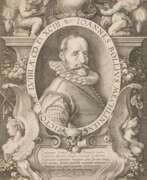

Hans Bol was a Flemish artist renowned for his miniature paintings and prints. Born in Mechelen, Bol was a pivotal figure in the transition from the world landscape tradition to a more realistic portrayal of nature. His early works as a 'water-verwer' offered affordable wall decorations but were susceptible to copying. This led him to create intricate miniatures on parchment, a medium less easily replicated.
Bol's influence on landscape art in the Low Countries is significant. His realistic landscapes, often featuring biblical scenes or daily life, showed a departure from imaginary landscapes, which was common at the time. This shift was partly due to the influence of Pieter Bruegel the Elder. Bol's completion of the Four Seasons series, initially started by Bruegel, established him as a master of landscape art, blending detailed observation with imaginative elements.
Notably, Bol's works are present in prestigious institutions such as the Metropolitan Museum of Art, where pieces like "The Prodigal Son" and various landscapes reflect his mastery of pen, ink, and wash. His artworks, like the "Landscape with a View of Antwerp," stand testament to his skill in capturing the essence of the Dutch landscape, influencing a generation of Dutch painters.
For collectors, auctioneers, and art connoisseurs, Hans Bol's legacy offers a glimpse into the evolution of landscape painting. His works not only adorned the homes of the affluent during his time but continue to be celebrated for their historical and artistic value.
To stay informed about sales and auction events featuring Hans Bol's masterpieces, sign up for updates. By subscribing, you will receive notifications only for new product sales and auction events related to this eminent artist, ensuring you don't miss the opportunity to own a piece of art history.


Schelte Adamsz Bolswert was a leading Dutch engraver, noted for his works after Rubens and Van Dyck. Both he and his older brother, Boetius à Bolswert, worked in Amsterdam and Haarlem before settling in Antwerp. For the last five years of his life Boetius worked exclusively on engravings after Rubens. Bolswert's plates were worked entirely with the graver, and he does not seem to have made any use of the drypoint. The freedom which this excellent artist handled the graver, the picturesque roughness of etching, which he could imitate without any other assisting instrument, and the ability he possessed of distinguishing the different masses of colours, have always been admired by the conoisseurs".


Charles Bonier was a Belgian artist, celebrated for his contributions to painting, lithography, and aquarelle. Born in Brussels in 1814, Baugniet's artistic journey began at the Académie Royale des Beaux-Arts, where he honed his skills under notable instructors. His early forays into lithography, starting in 1827, set the stage for a distinguished career that would intertwine with the cultural and historical fabric of the 19th century.
Charles Boniers artistry gained prominence with his lithographic portraits, particularly those featured in L'Artiste magazine in 1833. His collaboration on a series of portraits for the Belgian House of Representatives further solidified his reputation. However, it was his court appointment as a painter to the Belgian Royal Family in 1841 that marked a significant milestone, elevating his status and expanding his influence beyond Belgian borders.
In 1843, Charles Boniers talents took him to London, where he became a sought-after portraitist among the elite, capturing the likenesses of figures like Prince Albert, Charles Dickens, and Hector Berlioz. His move to Paris in 1860 coincided with the rise of photography, yet Bonier adeptly transitioned, focusing on paintings that reflected the Second French Empire's elegance.
Today, collectors and art enthusiasts cherish Charles Boniers works for their historical value and artistic merit. His ability to capture the essence of his era and subjects makes his art a prized possession in galleries and collections worldwide.
For those fascinated by the intersection of art, culture, and history, Charles Boniers oeuvre offers a compelling glimpse into the 19th century's artistic and societal landscapes. To stay informed about new discoveries and auction events related to Charles Boniers works, sign up for updates and delve deeper into the legacy of this remarkable artist.
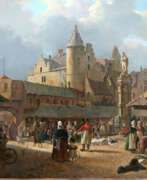

François-Antoine Bossuet was a painter and draughtsman of the Belgian school. Bossuet is known for his depictions of the landscapes, cities and monuments of Spain and Italy, with an emphasis on historic places, occasionally with genre scenes of everyday life. He is noted for the excellence of perspective in his paintings. He was professor at the Academy of Fine Arts in Brussels, from 1855 until 1876. His works may be seen in the Royal Museum of Fine Arts, Antwerp, the Royal Museums of Fine Arts of Belgium in Brussels, and the Victoria and Albert Museum in London.
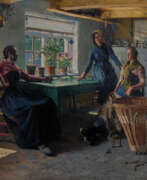

Aloïs Boudry was a Belgian painter known for his portraits, still lifes and interiors. He studied at the art schools in Ypres and Roeselare and finished at the Royal Academy of Fine Arts (Antwerp). In 1885, he joined "Als ik Kan" (If I Can), an association of visual artists devoted to preserving traditional methods. He participated in the exposition "Brussels International 1910", where he won a silver medal. When the seaside resort of Knokke-Heist began a promotional campaign in 1913, he designed the posters, which became well-known. At the outbreak of World War I, he fled to England and established himself as a portraitist. Wherever he was, he sought out humble people as the subjects for his paintings. His depictions of the fisherman of Nieuwpoort are especially popular. Many of them can be seen at the National Fishery Museum in Oostduinkerke.


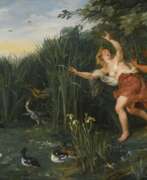

Jan Bruegel the Younger was a Flemish Baroque painter. He was the son of Jan Brueghel the Elder, and grandson of Pieter Bruegel the Elder, both prominent painters who contributed respectively to the development of Renaissance and Baroque painting in the Habsburg Netherlands. Taking over his father's workshop at an early age, he painted the same subjects as his father in a style which was similar to that of his father. He regularly collaborated with leading Flemish painters of his time.
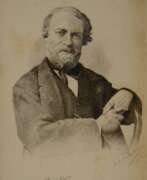

Théodore-Joseph Canneel was a Belgian portrait and genre painter, lithographer and art teacher. From 1830, Theodore Canneel learned the craft of lithography in the printing shop where his father worked. He then became a student of the painter Pieter van Hanselaere. From 1838 to 1841 he combined his profession with an education at the Koninklijke Acaďemie voor Schone Kunsten van Gent. He taught there from 1843. From 1848 to 1850 he undertook a study trip to France and Italy. On his return in 1850 he was appointed director of the Ghent Academy. In 1869 he became inspector at the Belgian drawing schools and academies. He also became a corresponding member of the Royal Academy of Sciences and Fine Arts of Belgium, the Koninklijke Academie voor Schone Kunsten van Antwerpen and an honorary member of the Philadelphia Academy. For the services rendered, he was appointed officer of the Belgian Order of Leopold.
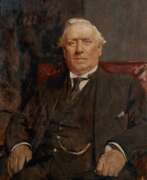

André Edmond Alfred Cluysenaar was a Belgian painter. He was especially known for portraits and female figures. He was member of the Cluysenaar family, descendant from a long line of architects who originated in Aachen. He received his first art lessons from his father, then studied with François-Joseph Navez. Initially, he worked as a sculptor, but devoted himself entirely to painting after 1902. He was firmly grounded in the romantic style at first; producing still lifes and genre scenes, but later turned to impressionism and painted mostly female figures, often semi-nude. He also executed monumental ceiling paintings for the City Hall in Saint-Gilles. During World War I, he lived in London where he established a reputation painting portraits of notable people, including the Royal Family, which were done in a more commercial style using Alfred Stevens as a model. Most of these portraits may be seen in the National Gallery.


Marie Collart-Henrotin was a Belgian artist who mainly painted landscapes and animals. Collart was primarily self-taught as an artist. She became a founding member of the Société Libre des Beaux-Arts in 1868. In 1870, she won a gold medal at the Salon des artistes français. She became the first women to be named a Chevalier in the Belgian Order of Leopold in 1880. Collart exhibited her work at the Palace of Fine Arts and The Woman's Building at the 1893 World's Columbian Exposition in Chicago, Illinois. Her work is included in the collections of the Royal Museum of Fine Arts Antwerp and Royal Museums of Fine Arts of Belgium.
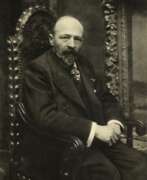

Franciscus Eduardus Maria (Franz) Courtens (1854–1943) was a Belgian painter. He was a leading figure in the Dendermonde School, famous for his paintings of nature and landscapes. Courtens was professor at the Royal Academy of Fine Arts (NHISKA) in Antwerp from 1904 till 1924. He was a personal friend of Leopold II, who gave him the privilege of free access to the royal Parc of Laeken. Some of his paintings stil remain in the Royal collection.


Herman Courtens was a Belgian painter. Herman Courtens was son of Franz Courtens who became his first teacher. He was also a student of Isidore Verheyden at the Academy of Fine Arts in Brussels. He became a teacher at the Higher Institute of Fine Arts in Antwerp. This was the perfection after the ordinary Academy studies. Herman Courtens painted figures, genre scenes, portraits, landscapes, flowers and interiors. His works often have a somewhat busy, overloaded image.
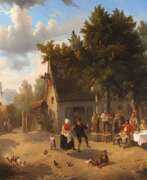

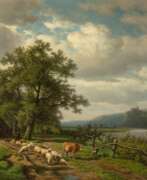

Alexander Joseph Daiwaille was a Dutch portrait painter. He specialized in painting portraits, like his father, although he later in life painted landscapes. He traveled and worked all around the Netherlands and Germany. Daiwaille then moved and settled in Brussels where he lived until his death in 1888.
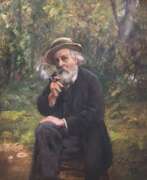

Léon Marie Constant Dansaert was an outstanding Belgian artist and illustrator. His work has left a significant trace in the world art history and art history due to his unique style and skill as a painter.
Léon Marie Constant Dansart was famous for his portraits and genre scenes, which were characterised by a deep psychological understanding of the models. In his works, the desire to convey not only the physical resemblance, but also the inner world of the portrayed personalities is clearly visible.
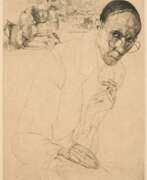

Jules De Bruycker, a Belgian graphic artist and etcher, is renowned for his depictions of Ghent, cathedrals, war scenes, and book illustrations. He achieved technical virtuosity in his prints and was considered one of Belgium's greatest etchers. His work showcased crowds and dramatic lighting, providing an intimate view of daily life in Ghent. De Bruycker's influences ranged from Flemish traditions to artists like Brueghel, Bosch, and Ensor. His later work included prints of cathedrals, figure studies, and sensuous nudes. De Bruycker's art greatly influenced his contemporaries, including Gustave van de Woestijne.
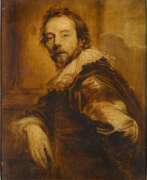

Adam de Coster, born around 1586 in Mechelen and passing away in 1643 in Antwerp, was a renowned Flemish painter and a key figure among the Antwerp Caravaggisti. This group of artists was part of an international movement that interpreted Caravaggio's work in a personal manner, known for their genre scenes with strong chiaroscuro effects. De Coster was particularly celebrated for his nocturnal scenes, earning him the nickname "Pictor Noctium" (literal translation „Painter of Nights“) due to his preference for tenebrist scenes.
His works often depicted subjects similar to those found in Caravaggio's paintings, such as card sharps, fortune tellers, and musical performances, showcasing de Coster's fascination with the play of light and shadow. Notable pieces by de Coster include "Three Singers," which demonstrates his skill in rendering the texture of fabrics and the dramatic effects of light on his subjects, and "A Man Singing by Candlelight," capturing a moment's drama through meticulous lighting.
Adam de Coster's art continues to captivate audiences with its atmospheric intensity and meticulous attention to detail. His contributions have solidified his place in the history of Flemish painting, with works featured in prestigious collections, including the Liechtenstein Museum in Vienna and the National Gallery of Ireland.
For collectors and experts in art and antiques, Adam de Coster's masterpieces represent a fascinating intersection of Flemish tradition and Caravaggesque innovation. To stay informed about new discoveries, sales, and auction events related to Adam de Coster, consider signing up for updates from art galleries and auction houses. This will ensure you have access to the latest information and opportunities to appreciate the legacy of this luminous master of painting.
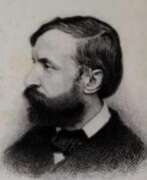

Charles Corneille Auguste de Groux or Charles Degroux was a French painter, engraver, lithographer and illustrator. As he moved to Belgium at a young age and his whole career took place in Belgium he is usually referred to as a Belgian artist. His depictions of scenes from the life of the disadvantaged and lower-class people of his time mark him as the first Belgian social realist painter. These works made him the precursor of Belgian Realist artists such as Constantin Meunier and Eugène Laermans. De Groux worked in different media, including oil painting, watercolor, pastel, engraving and lithography. He started out as a painter of history and religious scenes in the Romantic style then prevalent in Belgium. He later developed his own realist style which shows the influence of Courbet as well as genre painters of the 17th century. De Groux' social realist works contain many religious overtones and references.
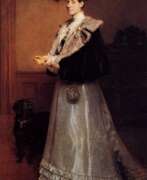

Edouard de Jans was a Flemish portrait and genre painter. Although he specialized in portraits, he also did Biblical scenes, history paintings and landscapes. In 1876, he received a scholarship from the Prix de Rome for his painting "Return of the Prodigal Son", which enabled him to travel throughout Europe, visiting France, Italy, Germany and Austria. When he returned to Antwerp in 1889, he was appointed a Professor at the Academy and held that position until his death.
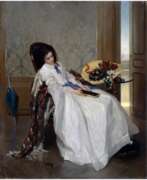

Gustave Léonard de Jonghe was a Flemish painter known for his glamorous society portraits and genre scenes. After training in Brussels, he started out as a painter of historical and religious subjects in a Realist style. After moving to Paris where he spent most of his active career, he became successful with his scenes of glamorous women in richly decorated interiors. His portrait paintings depict the lifestyle of the contemporary, fashionable city dwellers. Gustave de Jonghe painted many scenes of mothers with their children (usually a daughter) in intimate settings. Through the choice of pose, clothing and setting de Jonghe characterized the type of person represented. The title of his paintings often hinted at the narrative of the picture, such as Going to the ball. His pictures aimed to evoke the quiet joys of family life among the prosperous bourgeoisie. He worked in oil as well as watercolour. While some of his works are found in international museums such as the Hermitage and the Musée d'Orsay, most of his work is held in private collections.


Aloïs De Laet was a Belgian painter. As a painter, Alois De Laet was a self-taught artist who, however, learned a lot from his two uncles who were decorative painters. In 1900 he was the first to exhibit in the Cornelis Landschotkapel with the social philosophical movement 'De Kapel'. De Laet called himself one of the first Antwerp socialist artists. He painted portraits, genre scenes and landscapes with a melancholy atmosphere. Under the influence of luminism, his color palette became brighter over the years. He was a member of several art circles, including Eenigen, Als ik Kan, de Scalden, La Libre Esthétique and Vie et Lumière.




Edmond De Schampheleer was a Belgian landscape painter and engraver. After completing his studies with Eugène-François de Block in Antwerp, he set himself up as a landscape painter; taking a realistic approach, derived from Théodore Fourmois and the French artists of the Barbizon School. He also combined plein aire techniques with large-scale painting in his studio. His style increasingly came to resemble that of the 17th century Dutch artists.
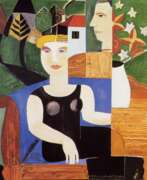

Gustave Franciscus De Smet was a Belgian painter. Together with Constant Permeke and Frits Van den Berghe, he was one of the founders of Flemish Expressionism. In 1908, he and his wife followed Léon to the artists' colony in Sint-Martens-Latem. There, they initially came under the influence of Luminism and the painter Emile Claus, who lived in nearby Astene. At the beginning of World War I, he and his family joined his friend, Van den Berghe, and fled to the Netherlands. From 1914 to 1922, they moved about, visiting and staying at the art colonies in Amsterdam, Laren and Blaricum.[2] His meeting with the Expressionist painter Henri Le Fauconnier marked a turning point in his style which, up until then, owed much to Cubism. In 1927, he settled in Deurle. It was there that his mixture of Expressionism and Cubism peaked, with a series of works depicting circus, fairground and village scenes. After his death in Deurle at the age of sixty-six, his house was preserved as a local museum.
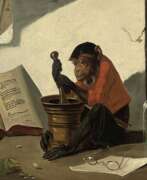

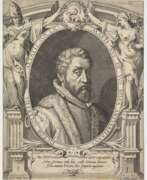

Marten de Vos (or Maarten de Vos, or Maerten de Vos) was a Dutch painter, draughtsman and graphic artist, dean of the Antwerp Guild.
After studying in Rome and Venice, de Vos returned to his native Antwerp in 1558 and became one of the city's leading artists. He created altarpiece images for many of Antwerp's churches. Many of his religious and historical paintings were later engraved, making him known throughout Flanders.
De Vos was also the founder of the Society of Romanists, whose members were famous artists and humanists of the time who appreciated the humanistic culture of Rome.
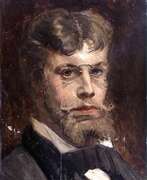

Jean-Joseph Delvin was a Belgian painter who specialized in scenes with animals (primarily horses). He attended the Royal Academy of Fine Arts in Ghent, where he studied under Théodore-Joseph Canneel, and worked in the studios of Jean Portaels in Brussels. Later, he undertook study trips to France and Spain. For many years, he shared a small workshop in a garden shed with Gustave Den Duyts. In 1883, he was invited to join the secessionist group Les XX, but he resigned only a few years later in 1886. He was also a member of La Libre Esthétique and Kunst van Heden (Art for Today) in Antwerp. At about that time, he began teaching at the Academy in Ghent and later became its Director (1902–1913). Among his many well-known students there were Albert Baertsoen, Gustave De Smet, Frans Masereel, George Minne and Frits Van den Berghe.


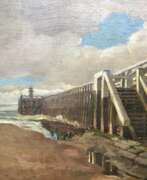

José Dierickx, known as Joseph Dierickx, was a Belgian painter. Joseph Dierickx is a painter of historical scenes, genre scenes, also a landscape and portrait painter. He also produced many murals. His realistic works executed from nature are luminous and his subjects well arranged in space. In 1892, he was co-founder of the Brussels artistic circle Pour l'Art. He teaches at the Saint-Michel college and at the school of decorative arts in Ixelles. His work was part of the painting event in the art competition at the 1928 Summer Olympics.


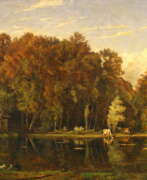

Théodore Fourmois was a Belgian landscape painter and printmaker. Théodore Fourmois learned drawing in the lithographic's workshop of Antoine Dewasme-Pletinckx in Brussels. He first exposed his works in this city in 1836. He began painting landscapes of Ardennes and Campine, several studies and panoramic views while traveling in Dauphiné and Switzerland. He took part, in 1855 and 1867, at the Exposition Universelle in Paris. Many of his works are exposed in the Royal Museums of Fine Arts of Belgium.
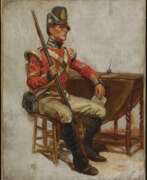

Emile Edwin Ganz is a Swiss-Belgian painter, specializing in the representation of horses and military scenes. In his early days, Ganz mainly drew military scenes, a genre that only a few 19th-century artists mastered. His masterpiece in the genre is The Attack of Scherpenheuvel, a report on the maneuvers of the grenadiers in 1894. In 1901 he entered the service of Princess Clémentine as a painter; he held this position until 1903. In 1903, he also brushed some of King Leopold II's horses. From that moment, he was no longer interested only in the horse itself, but in the regional draft horse, as well as in the people and the rural world: newspaper sellers, old horses in a depot, the harvest in the fields , beet harvest, landscape. Many of his designs for military uniforms were printed in color lithograph.
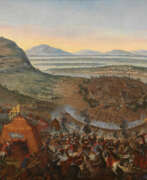

Frans Geffels, known in Italy as Francesco Geffels (25 August 1624 – 18 February 1694) was a Flemish painter, printmaker, architect, stage designer and designer of ephemeral structures for solemn and festive occasions. After training in his native Antwerp, he was mainly active in Mantua, where he was prefetto delle fabbriche to the Duke, a role that gave him the direction of the artistic and construction activities undertaken by the Ducal court. He worked also on projects for the local aristocratic class of Mantua. In addition, he completed projects for the Liechtenstein princes and for the imperial court in Vienna.
He was both a canvas and fresco painter. He created portraits, history subjects, military scenes, architectural scenes and genre art, in particular merry companies. Geffels is mainly remembered as the designer of some of the key examples of Baroque architecture in Mantua.
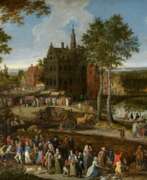

Peeter Gijsels was a Flemish painter of the Baroque period.
Peeter Gijsels is known for his landscapes, architectural compositions and still lifes. He is also considered a genre painter as he painted scenes of village markets and church kermis. His landscapes in the style of Jan Bruegel the Elder were in great demand during his time.
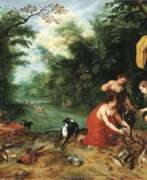

Jacob Grimmer was a Flemish painter who was active during the Late Renaissance. He specialised in landscapes and genre scenes, often depicting the everyday life of peasants.
His style was strongly influenced by Pieter Bruegel the Elder and the works of Leonardo da Vinci and Raphael.
Grimmer's paintings are characterized by detailed, realistic depictions of nature. His landscapes are characterized by wide expanses and intricate detail.
Jacob Grimmer was known for his ability to capture the nuances of human behaviour, so his genre works depict the lives of peasants with a touch of humour and whimsy.
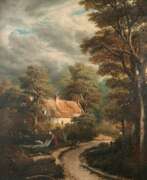

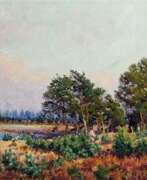

Alfred Hazledine was a Belgian painter and graphic artist. Hazledine was a student of Ernest Blanc-Garin in Brussels and of Adrien-Joseph Heymans. He lived and worked for a long time in Wechelderzande, where there was a true artists' colony. He mainly painted landscapes in Impressionist style. Hazledine was a member of the Vie et Lumière group that brought together Impressionists and Luminists for exhibitions, and was also a member of L'Estampe and of the National Confederation of Painters and Sculptors of Belgium.
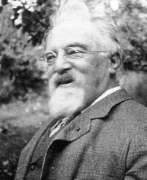

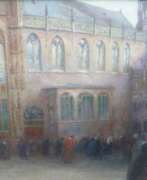

Jozef Horenbant was a Belgian painter. Horenbant was a student at the Academy of Ghent. He became a teacher in 1886 and director of the Academy in Sint-Niklaas in 1900. He held the directorship until 1933. He was also director of the Drawing School in Ledeberg. Horenbant painted atmospheric, intimate genre scenes, interiors (especially of churches) and landscapes. He was co-founder of the Koninklijke Wase Kunstkring, a member of Als ik Kan and founder-curator of the Museum of Sint-Niklaas. He donated part of his oeuvre to the Museum of Fine Arts in Ghent, as well as his collection of old engravings and old sculptures. From 1911 to 1918 he was president of the Cercle Artistique et Littéraire in Ghent.


Jan Baptist Huysmans was a Belgian orientalist painter, traveler and writer.
After graduating from the Antwerp Academy, Jan Baptist Huysmans traveled extensively. During his long and prolific artistic career he visited Greece, Turkey, Syria, Palestine, Egypt and Algeria. These travels resulted in numerous sketches and studies, sketches, paintings and memoirs by the artist, who was fascinated by the culture and landscapes of the countries he saw.
In addition to genre paintings of Eastern life, the artist created religious compositions for churches in Jerusalem and decorative panels for church and municipal buildings in Belgian cities.
Huysmans lived most of his professional life in Paris and exhibited in France, England, and Scotland. He also published several illustrated books about his travels, notably Travels in Italy and the East in 1856-1857.
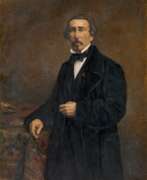

Jacobus Albertus Michael Jacobs, known as Jacob Jacobs was a Belgian landscape and seascape painter in the Romantic style, with a preference for northern and "oriental" scenes. His first exhibitions came in 1833. He took a trip to the North Sea in 1834, and a final study trip through the Netherlands in 1837 produced much material. In 1838, he left on a long sea voyage that would take him to Gibraltar, the North African coast, Egypt, the Dardanelles, Istanbul (where he remained for several months), Asiatic Turkey and Rhodes.[1] While in Ankara, he met and befriended his fellow Belgian painter, Florent Mols, and they continued travelling together; sailing down the Nile as far as Nubia. During these travels, he compiled two huge albums of drawings and notes that he would use for inspiration the rest of his life.


Eugène / Eugeen Joors was a Belgian painter in the realistic style. He studied from 1865 to 1870 at the Royal Academy of Fine Arts (Antwerp). In 1886, he became a teacher of still-life painting. He executed both the traditional, carefully arranged still lifes and the more natural-appearing floral variety as well as a great variety of landscapes, portraits and genre scenes. From 1879, he was a regular exhibitor in Antwerp and abroad, receiving a gold medal at a show in Munich. He also assisted Charles Verlat in producing his famous panorama of the Battle of Waterloo.
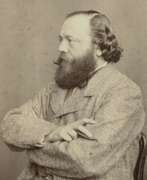

Victor Lagye (1825–1896) was a Belgian 19th-century painter known for his genre scenes, historical and religious works. Born in Antwerp, he studied at the Royal Academy of Fine Arts there. He collaborated closely with the artist Henri Leys, contributing to large-scale murals and the restoration of historic buildings. His works are characterized by meticulous detail and attention to historical costumes and interiors.
Though talented, he remained overshadowed by more famous contemporaries. Some of his pieces are housed in the Royal Museum of Fine Arts Antwerp. Details about his birth and death locations, as well as his biography, are less documented compared to leading artists of his time.


Paul Lauters / Lauteri was a Belgian printmaker, illustrator and painter. Lauters studied at the Académie Royale des Beaux-Arts from 1820 to 1823. From 1823 he worked for the Gouban & Dewasme-Pletinckx lithographic company. In 1836 he taught at the École Royale de Gravure. He collaborated with the painter Théodore Fourmois in 1839, producing images of the abbey ruins at Villers-la-Ville. In 1840 Lauters produced illustrations for Les Aventures de Till Eulenspiegel and for Les Aventures de Jean-Paul Choppart. In 1846 Lauters illustrated Le Juif errant. In 1848 he was appointed professor at the Académie des Beaux-Arts of Brussels.
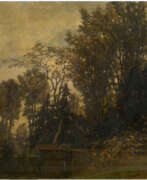

Joseph Henri Hubert Lies was a Belgian Romantic painter, draughtsman and engraver. He worked in a wide range of genres including history painting, landscapes, genre scenes and portraits. He enjoyed a European-wide reputation during his lifetime.
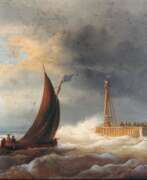

Egide (Egidius) Linnig was a Belgian painter, draughtsman and engraver. The subject matter of Linnig's work is mainly marines, ship portraits and coastal landscapes. He also had an interest in depicting the Flemish coastal towns. Linnig was an important representative of the Romantic-Realist movement in Belgian marine painting. Linnig's marine paintings are always well balanced and pay particular attention to topographical accuracy. His work provides an important testimony on the history of seafaring since he worked during the pivotal period that marked the transition from sailing ships to steamships. Linnig trained early on as an etcher and was one of the first to practise this art as an autonomous genre. He is regarded as one of the first realistic engravers in Belgium. His etchings, while technically finished, preserve a character of free and swift execution.
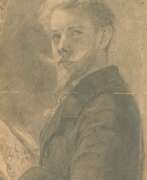

Henry Luyten was a Belgian painter of Dutch origin. He is known for his genre scenes, landscapes and portraits.
Henry Luyten was influenced by the 19th century Hague School and the Barbizon School, as well as 17th century Dutch and Flemish painting.
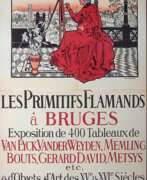

Amédée Ernest Lynen, who often signed his works Am. Lynen, was a Belgian painter, illustrator and writer. In 1880, he was one of the founders of the artistic group L'Essor after it had separated from the academy, and he co-founded its successor Pour l'Art in 1892. In 1895, he founded the "Compagnie du Diable-au-corps", an artistic association which organised evenings with theatre and poetry, and which existed at least until 1899. It also published a satirical newspaper, Le Diable au Corps. In 1903, two works on paper were bought by the Royal Museums of Fine Arts of Belgium. In 1930, a retrospective of his works was organised by the Cercle Artistique et Littéraire in the Vauxhall, Brussels.
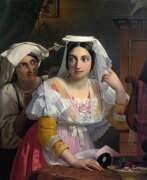

Jan Baptist Lodewyck Maes was a Belgian genre painter active in Italy. Maes studied at the Academy of Ghent. He exhibited for the first time at that city's fair in 1810. He won prizes in all the competitions he entered and in 1820 received a grant from the city of Ghent. Thanks to the Belgian Rome Prize received in 1821, he first visited Paris and then went on to Italy. In 1822 he copied works by old masters in the Uffizi Museum. In 1824 he settled in Rome. Maes kept in touch with his hometown and regularly sent works to Belgian salons. He was a corresponding member of the Royal Netherlands Academy of Sciences.
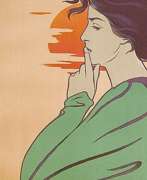

Henri Georges Jean Meunier, a Belgian Art Nouveau artist, was renowned for his multifaceted talents as a lithographer, etcher, illustrator, bookbinder, and poster designer during the Belle Époque. Born into a family with artistic lineage, Meunier honed his skills in his father's workshop before diversifying his artistic pursuits. His works are celebrated for their strong imagery and use of flat colors, a technique inspired by Japanese prints, which gave his art a distinct and powerful visual appeal.
Henri Meunier's contributions to the art world were significant, particularly in the realm of lithography. His lithographs, frequently published in the prestigious L'Estampe Moderne, stand out for their vibrant colors and compelling designs. These works, alongside his color aquatints, which are lauded for their freshness and appeal, highlight his mastery in blending color and form to capture the viewer's attention.
Despite the scarcity of his works today, Henri Meunier's legacy in the Art Nouveau movement remains impactful. His ability to draw the viewer into his art through his innovative use of color and design made him a sought-after artist in Brussels around 1900. His artistic contributions continue to be celebrated, offering a glimpse into the vibrancy and dynamism of the Art Nouveau era.
For enthusiasts and collectors keen on exploring the unique artistry of Henri Georges Jean Meunier, staying informed about upcoming sales and auctions can provide an opportunity to own a piece of this artistic legacy. By signing up for updates, you can ensure you're the first to know about new product sales and auction events featuring Henri Meunier's captivating works.
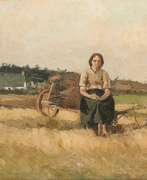

Isidore Meyers is a Belgian landscape painter and draftsman. Around 1850 he studied at the Academy of Fine Arts in Antwerp with Jacob Jacobs. In Paris, where he studied at the École des Beaux-Arts, between 1855 and 1858 Meyers became acquainted with the French painters of the Barbizon school, which opposed formal academicism in landscape painting. In 1858, after returning to Brussels, he began to study in Campina, from where he graduated in October 1861. The Kalmpthout school was born there. In 1865 he became a professor at the Dendermonde Academy, famous for its harmonies of gray tones.
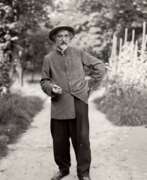

Constant Montald was a Belgian painter, muralist, sculptor, and teacher. In 1874, while receiving an education in decorative painting at the technical school of Ghent during the day, Montald also enrolled in the evening-classes of the Royal Academy of Fine Arts in Ghent. There he won in 1885 a competition and received a grant from the city which enabled him to live and study briefly in Paris at the École des Beaux-Arts. In Paris he painted his first monumental canvas, The Human Struggle. In 1886, Montald went on to win the Belgian Prix de Rome. He then went on a grand tour of Italy. He traveled extensively until he eventually settled in Florence, where he made preparations for a Grand work he eventually completed in Rome. This grand work, titled "Social Contradictions", was kept in the basement of the Royal Museum of Art and History of Brussels after it was displayed there in 1890 after being sent over from Rome. The First World War prevented Montald from painting Monumental works, instead he focused on painting on an easel. Montald co-founded the group L'art monumental. This group promoted a decorative monumental style connected to architecture.
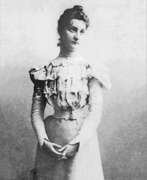

Jeanne (Jenny) Montigny was a Belgian painter. At seventeen, she decided to become an artist, knowing that she could not count on her parents' support. After seeing a painting by Emile Claus (The Kingfishers), Montigny decided to seek out a position in his studios near Deinze. In the summer of 1893, she and several other female students took his course in plein air painting. In 1902, she made her debut at the Ghent Salon, followed by shows in Paris. She later became a member of the luminist group Vie et Lumière. At the outbreak of World War I, she followed Claus and his wife in emigrating to London, where she became a member of the Women's International Art Club and exhibited at the Grafton Galleries. After the war, she returned to Belgium. In 1923, she joined the Société Nationale des Beaux-Arts.
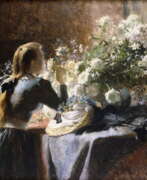

Frans Mortelmans was a Belgian painter, draughtsman and engraver. He initially produced portraits, history paintings, marines and genre scenes. From 1892 onwards, he almost exclusively painted very decorative and harmoniously composed still lifes and flower pieces. It is through these works that he established his reputation. His compositions with pink roses are in particular highly valued. His work situates itself between impressionism and realism with some luminist touches. He produced many pastel works. Frans Mortelmans was a very prolific painter. To date, more than 850 of his works have been inventoried.


Jan Antoon Neuhuys was a Dutch history and genre painter. He was a student of Nicaise de Keyser and the Koninklijke Academie voor Schone Kunsten van Antwerpen. In 1858, after 4 years of study, he received the 1st prize there. Jan Antoon Neuhuys dealt with history and genre painting. He participated in exhibitions in Amsterdam 1853 and 1862, Antwerp 1861-1882 and The Hague 1859, 1863, 1869, 1878 and 1881.


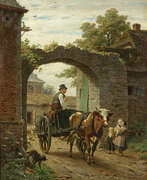

André Ploumo was a Belgian realist painter who specialized in genre scenes, antique interiors, landscapes and images of poultry. He studied at the Royal Academy of Fine Arts in Antwerp and worked for some time in the workshop of Nicaise de Keyser on the Ossenmarkt. At the age of 20, he completed his studies, left the Academy and mainly painted paintings with interiors and figures, inspired by the painting of the 16th-17th centuries. A lucrative genre practiced by many Antwerp artists at the time. In the 1860s, Plumo painted mainly historical genre scenes. In the 1860s he met Jacques Rossels, Isidore Meyers and other landscape painters in Kalmthout. He traveled through the Ardennes, where he painted the Meuse valley and forest scenes several times. Due to his frequent stay in Kalmtaut and its environs, he began to show an increasing interest in nature and animals, he painted pictures depicting livestock and birds. In 1872 he was awarded a diploma and a medal at an exhibition in London.
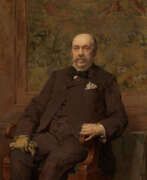

Jean-François Portaels was a distinguished Belgian painter. He is celebrated for his mastery in Orientalist art, genre scenes, and portraits. His education under the tutelage of François-Joseph Navez at the Academy of Brussels shaped his early artistic direction.
Portaels' career was marked by significant academic roles, including his tenure as the director of the Academy of Fine Arts in Ghent and later the Académie Royale des Beaux-Arts in Brussels. His influence extended beyond Belgium through his extensive travels across Europe and North Africa, where he absorbed and later depicted the exotic and vibrant cultures of Morocco, Algeria, Egypt, and Lebanon.
His works, such as "The Oriental Beauty" and "Portrait of Aouicha," are celebrated for their detailed depiction of Eastern subjects, characterized by elaborate costumes and serene expressions. These paintings not only display his technical skill but also his ability to convey the subtle nuances of different cultures.
Portaels was also a key figure in monumental art in Belgium, contributing to national identity through his historical and biblical scenes painted for many Belgian churches. His legacy is preserved in his contributions to the Belgian Orientalist school and his role in shaping the next generation of Belgian artists.
For collectors and experts in art and antiques, Jean-François Portaels' works offer a unique glimpse into the 19th-century Orientalist movement. To stay informed about exhibitions and sales featuring Portaels' art, sign up for our updates and ensure you don't miss out on acquiring a piece of this influential artist's legacy.
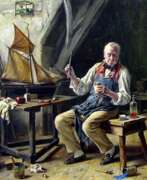

Gerard Jozef Portielje was a Belgian painter of genre scenes. He was born in Antwerp, the son of painter Jan Portielje. His younger brother, Edward, was also a painter. Portielje specialized in genre scenes in a variety of social settings, generally filled with people who might be described as "characters". They are often humorous (occasionally suggestive), and there is usually a sense that something is about to happen. The clothing and accessories point to the early nineteenth century, rather than his own times. He is particularly noted for his attention to fine detail. His paintings were usually priced according to the number of people they contained.


Edward Antoon Portielje was a Belgian genre painter. He was born to the painter, Jan Portielje. His older brother, Gerard, was also a genre painter. His first art lessons came from his father. Next, he attended the Royal Atheneum and, from 1873, took after-school classes at the Royal Academy of Fine Arts. From 1877 to 1881, he was a full-time student there. Genre scenes were his speciality, with an occasional portrait or seascape. Much of his inspiration came from the fishing communities in Zeeland. Many of his works are series of similar interior scenes. They generally consist of a room with a sunny window, occupied by women in traditional costume, engaged in some daily activity. These paintings were very popular; selling throughout Europe and the United States.


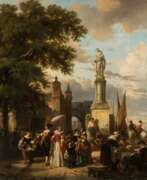

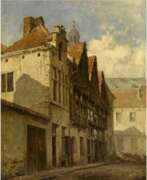

Hendrik Frans Schaefels or Henri François Schaefels, also known as Rik Schaefels was a Belgian Romantic painter, draughtsman and engraver known for his seascapes, cityscapes, genre paintings, landscapes with figures and history paintings. He worked in the Romantic style popular in Belgium in the mid nineteenth century and was highly esteemed in Europe for his representations of historic naval battles.
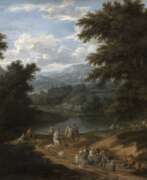

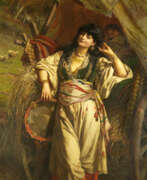

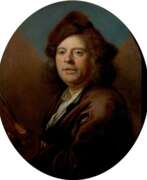

Jan Siberechts was a Flemish landscape painter whose career spanned both his native land and England. Initially, Siberechts developed a personal style of landscape painting in Antwerp, emphasizing Flemish countryside and country life. His work was influenced by Dutch Italianate landscape painters such as Nicolaes Berchem and Karel Dujardin, reflecting a blend of local and Italianate elements. This phase of his career was marked by vivid depictions of the Flemish rural life, with robust country girls in bright attire becoming a signature motif of his paintings.
Siberechts moved to England around 1672, where he significantly contributed to the English landscape tradition. In England, he painted decorations for the Duke's Cliveden House and later, traveled extensively, completing commissions for aristocratic clients. His English landscapes maintained their Flemish character but also started to focus more on universal themes, with less emphasis on figures and more on the scenery itself. These works are characterized by powerful trees, soft light on distant hills, and a relatively dark foreground to highlight the illuminated vistas in the background.
Siberechts is credited as the 'father of British landscape' for his pioneering country house portraits, blending detailed naturalistic views of stately homes into atmospheric landscapes. This innovative approach had a lasting influence on English landscape painting. His work, such as the views of Longleat and the Belsize Estate, represents an important step in the development of topographical painting, merging Flemish influences with the emerging English landscape tradition.
For collectors and experts in art and antiques, Siberechts' oeuvre offers a unique window into the transnational flow of artistic ideas in the 17th century, blending Flemish traditions with the nascent English landscape genre. His paintings, celebrated for their detail and historical topographical interest, can be found in prestigious collections such as the Tate Gallery London and the Victoria and Albert Museum.
For updates on exhibitions, sales, and auction events related to Jan Siberechts' work, art enthusiasts are encouraged to sign up for dedicated newsletters. This ensures that they remain informed about the latest opportunities to explore and appreciate the contributions of this influential Flemish artist to the landscape painting genre.
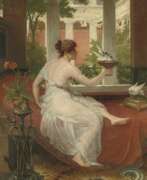

Joseph Stallaert was a Belgian painter; best known for his scenes from antiquity. In 1847, he was awarded the Prix de Rome and stayed in Italy until 1852. Upon his return, his mentor Navez exerted some influence to obtain a contract for him to do a painting for the Brussels Town Hall ("The Death of Everard 't Serclaes"). That same year, he became Director of the Academy of Fine Arts in Tournai. In 1865, he was selected to be the first teacher of "Drawing and Painting from Nature" at the Brussels Academy and held several important positions there over the next thirty years.


Joseph Édouard Stevens was a Belgian animalier painter and engraver. Partly self-taught, he finished his training in Paris, without enrolling in a school, and frequented the studio of Alexandre-Gabriel Decamps, as well as painters of the Barbizon School and of the "Groupe du Restaurant du Havre" including Thomas Couture, Eugène Isabey, Théodore Rousseau and others. He exhibited at the Brussels Salon from 1842. In 1852 he joined his two brothers in Paris where he lived for several years. He executed many drawings of horses in the Bois de Boulogne which he exhibited in Amsterdam in 1854, and later in Dijon in 1858. Stevens produced mostly canvases showing domestic animals (generally dogs, monkeys and horses) in sometimes curious or run-down settings far removed from Romanticism. This realism, of which he was one of the pioneers, attracted the interest from the 1850s of predominantly French critics and intellectuals.


Emile Thysebaert was a Belgian figurative painter. Thysebaert was a Post-Impressionist painter and etcher whose subject matter was very diverse: fringe people, alcoholics, folk, workmen, market squares, horse markets, balls, processions, draft horses, fishermen. In the later years he also painted images of Mechelen, the dunes in Oostduinkerke and Koksijde, the height of the Duden Park, Neerpede, etc. He used strong brushstrokes and striking colours. He was not influenced by the prevailing art movements, but always worked in his own realistic style and with a strong social commitment. Furthermore, wall paintings and some sculptures by him are known. Thysebaert became a member of the artists' group “Le Sillon”. He also became a member of “Labeur” and participated in the salons of “Labeur” among others. He was also a member of “If I can”, an Antwerp artists' group.
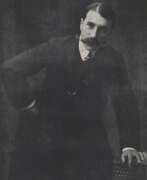

Fernand Toussaint was a Belgian painter and illustrator in the 19th century Belgian School. At age 15 he began studying art with Jean-François Portaels at the Académie Royale des Beaux-Arts and three years later left for Paris to continue his studies there. He made his study under the well-known Belgian portraitist Alfred Stevens. He specialised in painting portraits of women, still lifes and city-scapes, in the Impressionist, Art Nouveau, and Post-Impressionist styles. His works include paintings, water-colours and posters. He is also a famed artist to depict beautiful floral still lifes and interiors, coastal views and seascapes.




Edmond Jean-Baptiste Tschaggeny was a Belgian animal painter. Tschaggeny first studied privately together from 1834 to 1835 with Eugène Joseph Verboeckhoven, then from 1837 to 1838 at the Académie royale des Beaux-Arts de Bruxelles. He painted scenes with cattle and horses in the style of Verboeckhoven. The young shepherds accompanying the animals gave his works a sentimental touch. He is also known for portraits of purebred horses and bulls that have won a prize. He worked in Campine from 1846 and was one of the pioneers of the Campine painting school. He was a founding member of the Société royale belge des aquarellistes. In 1854 he was awarded the Knight's Cross of the Order of Leopold. Towards the end of his life he spent the winter months in Algeria, painting North African motifs. He illustrated anatomical books devoted to veterinary medicine.


Louis Tytgadt, also called Lodewijk Tytgadt, was a Flemish painter. He was trained at the Ghent Academy by Théodore-Joseph Canneel and then took painting lessons in Paris in the studio of Alexandre Cabanel. He mainly painted historical and Biblical scenes, as well as many portraits. In 1880 he was appointed teacher at the Ghent Academy, where he became director from 1892 to 1902. He promoted the construction of a new Museum of Fine Arts in Ghent, which was built in 1902; he became president of this museum until his death.
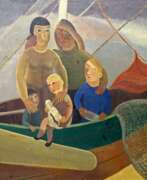

Edgard Tytgat is a Belgian painter, engraver, illustrator, draftsman, etcher, watercolourist and wood engraver. As an engraver and xylographer, he illustrated numerous works. His painting, in a style inspired by Post-Impressionism, is often described as naive painting, with scenes of daily life, interiors, fairs, lovers, but not devoid of sweet poetry. From 1950, he approached the representation of mythological legends sometimes bathed in a certain eroticism. Edgard Tytgat has participated in numerous exhibitions, both personal and collective, in Belgium and abroad.
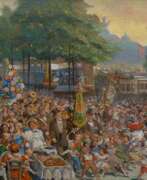

Médard Tytgat was a Belgian painter, lithographer, book illustrator and poster artist known for portraits, nudes, and landscapes. From 1890 to 1894, he studied at the Académie Royale des Beaux-Arts of Brussels with Jean-François Portaels. He took part in the art competitions at the 1924 Summer Olympics. Tytgat was considered a mediocre painter, but was more highly regarded as an illustrator.
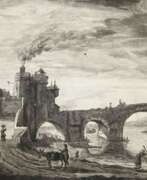

Jacob van der Heyden was a Flemish Baroque painter, sculptor and engraver. According to Houbraken he was a painter from Strasbourg who painted for royalty. According to the RKD he worked in Strasbourg, Frankfurt, and Sweden. and was known for portraits, landscapes and historical allegories. Most of his work that survives today are engravings. He died in Brussels.




